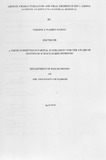| dc.description.abstract | CCR5 antagonists have clinically been approved for prevention or treatment of HIV/AIDS.
Countries in Sub-Saharan Africa with the highest burden of HIV/AIDS are yet to adopt these
regimen . However, HIV can also use CXCR4 as a co-receptor. There is hence a need to map
out cellular tropism of Kenya's circulating HIV strains to guide the impending use of CCR5
ant . j . The study aimed to determine the prevalence of CCR5- and CXCR4-tropic HIV-
1 strains among patients attending Kenyatta National Hospital. Blood samples were obtained
from HIV infected patients attending the comprehensive care centre, Kenyatta National
Hospital in years 2008 and 2009. The samples were separated into plasma and peripheral
blood mononuclear cells (PBMCs). Proviral DNA was extracted from PBMCs and
Polymerase Chain reaction (PCR) done to amplify the HIV env fragment spanning the C2-V3
region. The resultant fragment was directly sequenced on an automated sequencer (ABI,
3100). The HIV-1 env sequences were then entered into a variety of predictive algorithms:
amino acids at position 11/25 rule~ V3 net charge rule, Geno2pheno [co-receptor] and
dsKemel. Phylogenetic relationships were determined using CLUSTAL W and Neighbour
Joining method. A total of 84 sequences were successfully amplified and sequenced. HIV -1
R5 tropic strains were more prevalent in the study population according to all algorithms:
(7l.Ol,...., 69.41%. 72.5% and 82.890A. for amino acids at positions ll/25 rule. V3 net charge
rule, Geno2pheno[co-receptor] and dsKemel respectively). Phylogenetic analysis showed
that 75% were subtype A, 13% subtype C and 12% subtype D. There were no significant
differences in predicting the tropism using the four predicting tools (x.2 test, p=OJ 9). The
age,. sex and CD4 counts of the study participants were not associated with HlV -tropism (x2
test, p=0.4447, p=l.OOO and p=0.26 respectively). There was a tendency of a higher number
of X4 tropic viruses being in the treatment experienced group though not statistically
significant (1.2 test, p=0.31). However, a strong association was observed between HIV
tropism and HIV subtypes (x2 test, p=0.04), with subtype D harbouring mainly X4-tropic
strains. In conclusion, HIV -1 R5 tropic strains were the most prevalent in the study
population and HIV infected patients in Kenya may benefit from CCR5 antagonists.
However-,. there is need for caution where subtype D infection is suspected or where
antiretroviral salvage therapy is indicated. | en_US |



